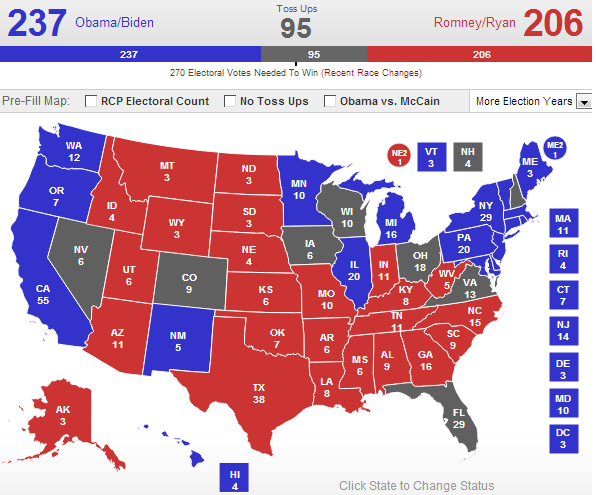It’s not new to write about the flaws of the electoral college: how it makes some states important and makes other states irrelevant, and how it produce perverse incentives in terms of policy. However what has become clear as we enter the final stretch of the 2012 is that the electoral college system is becoming more problematic in the age of precise and scientific campaign techniques.
The major parties have become remarkably good at targeting over the last 15 years. They have a better of sense of who can be won and who cannot, and are able to target their resources far more effectively.
When you combine these techniques with the electoral college, you see elections where fewer and fewer states are contested as battleground states.
Over the weekend the New York Times published a piece about how the number of states seriously contested by both parties has shrunk dramatically since close elections in 1960 and 1976. Indeed, the change is evident when comparing the 2012 race to the last three elections.
There are ten states that have been targetted by the Obama and Romney campaign for nearly all of their general election campaigning. As the campaign has wore on the seriously-contested states have narrowed to a bare eight states: Ohio, Florida, Virginia, Colorado, New Hampshire, Nevada, Iowa and Wisconsin. The states of North Carolina and Indiana were both won by Obama in 2008 but are generally considered out of reach.

The Times piece compares this to 1960, when Kennedy and Nixon visited almost every state, and in 1976 the biggest states were almost all swing states. This map is even tighter than the map in 2000, 2004 and 2008, which were historically tight elections in terms of the number of states up for grabs.
It has serious consequences for the election. Turnout is lower in safe states, and the most important election in the United States is becoming increasingly dominated by the parochial issues of a handful of states.
It seems impossible for there to be any move towards actually abolishing the Electoral College in the constitution. Even if Democrats and Republicans nationally both came around to the idea of abolishing the electoral college and moving to a system where the winner of the popular vote is elected, it would be extremely difficult to get three quarters of US states to agree to drop a system which favours a handful of states. For those states, it is a great deal.
However the one serious possibility is the ‘National Popular Vote’ plan. Under this plan, state legislatures can pledge that, once states that hold at least 270 electoral votes agree to the plan, they will give all of their electoral votes to the candidate who wins the national popular vote, regardless of the result in their own state.
This would allow the safe states that make up the vast majority of the country’s population to circumvent the balance of power held by an unrepresentative few. Eight states and the District of Columbia (who hold 132 electoral votes) have already agreed to the plan.
In the meantime, the small field of states which are actually being contested allows us to look past the polls showing sentiment nationally to state polls that give us a precise idea of how this week’s election will play out.
Later today I will blog about what the polls say about the race in the eight key states, and why that suggests this race is not as close as the media may want you to believe.



This looks like a Joh-style gerrymander.
Thank goodness we don’t have that garbage in Australia.
If only 20% of states are benefitting from the status quo, getting 75% to agree to change it should be possible, shouldn’t it?
Comments are closed.